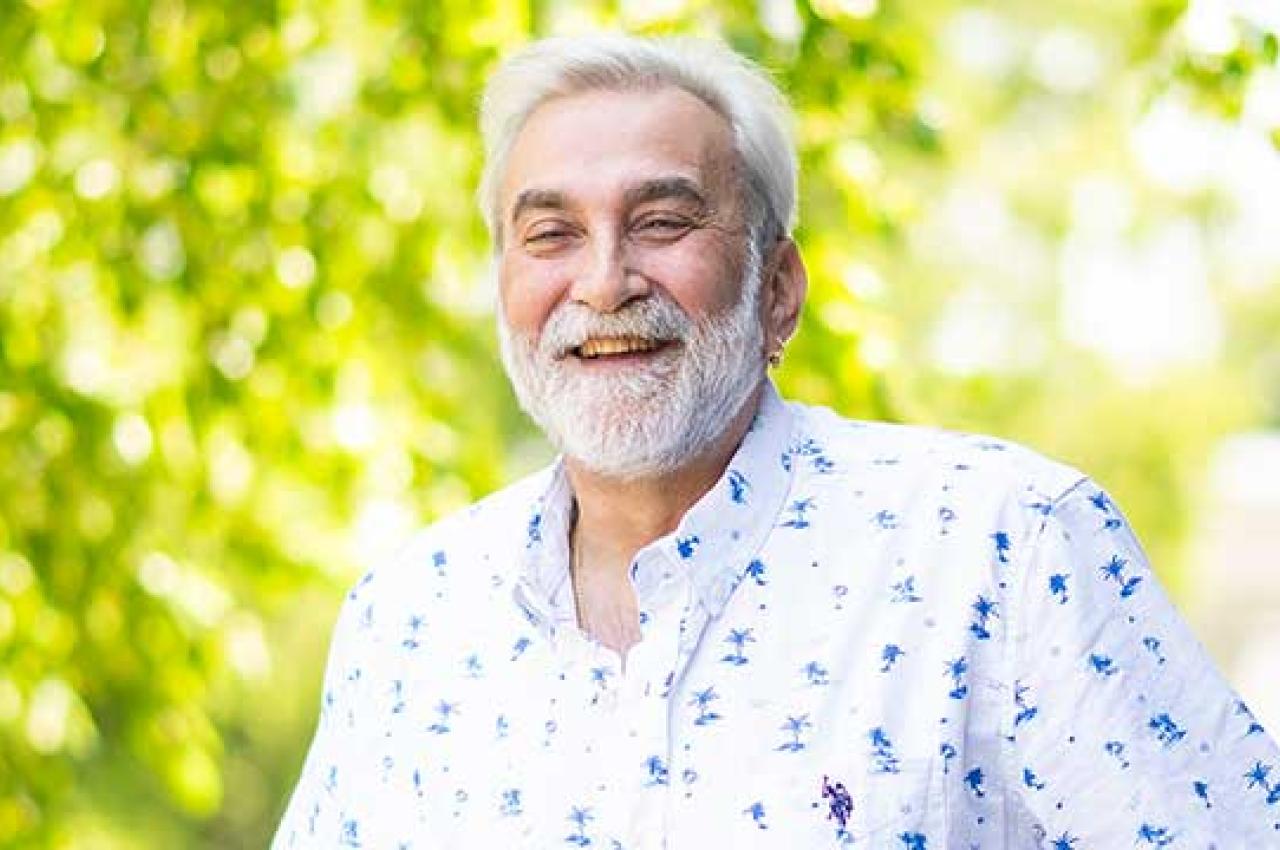For Some, ‘Group Magic’ Is the Key to Wellness
The first thing you should know about the Wellness Group program led by physician Wayne Altman and registered dietitian Kerri Hawkins, N06, is that weight loss is not necessarily the goal. Diet is considered a four-letter word. Instead, the groups consist of people with a shared goal of improving their overall health.
“The primary intent of this support group program is to establish healthier habits for life,” said Altman, who is the Jaharis Family Chair of Family Medicine and a professor at Tufts University School of Medicine. “There are so many fads that come and go in the wellness space. What we talk to people about was true 50 years ago, is still true now, and will be true 50 years from now.”
For over 15 years, the Wellness Group program has been run out of Altman’s family medicine practice in Arlington, Massachusetts. Close to 100 groups have completed the program, Altman estimates. The groups of 6-12 people meet weekly, both in person and virtually, for 15 sessions. There’s also an advanced group of individuals who have completed the program at least once (some have gone through it multiple times) and meet every other week for accountability sessions.
“The curriculum is focused around three pillars—exercise, nutrition, and behavior change—because those are the foundations of any habit change related to health conditions,” said Hawkins. It’s also based on the five dimensions of wellness: quality of food, quantity of food, exercise, steps (which are different than exercise), and sleep/stress.
“You could be doing all the right things with nutrition and movement, but if you are sleep deprived or in high-stress mode, you may not see progress,” Altman said.
Participants discuss a variety of topics — food shopping, cooking, movement, strength, exercise, emotions, and habits — and often share personal details about their life in the process.
“The curriculum is focused around three pillars—exercise, nutrition, and behavior change—because those are the foundations of any habit change related to health conditions.”
Secret Sauce for Success
Hawkins and Altman said the concepts in the curriculum remain largely unchanged since they created the program in 2009, though they have tweaked the details to account for certain trends over the years, such as intermittent fasting. Hawkins cited evidence that it can be effective for certain people, such as those who have diabetes, but she cautions women that longer fasts, such as 16 hours, may not be right for their bodies.
The program is action-oriented, and each week, participants are given a challenge meant to inspire behavior changes and good habit formation. One of the participants is designated as the “nudge” for the week, and their job is to ping the group email chain a few times with prompts or thoughts related to the challenge.
As they go through the 15-week curriculum, participants try various approaches and strategies to see what works or doesn’t work for them, and what makes a difference on how they feel. Participants essentially create their own customized version of a wellness path versus being on a particular diet.
Hawkins said they’ve had group participants who were vegan and others on carnivorous diets, as well as patients who had gastric bypass surgery and others taking injectable glucagon-like peptide 1 (GLP-1) medications. Regardless, the principles are the same.
In 2017, Altman and Hawkins published a paper in the Journal of the American Board of Family Medicine about the Wellness Group program and the habits it promotes. The study showed that participants were more likely to sustain wellness behaviors as a result of the program, and about 70% of patients who lost weight kept it off for three years.
Over the last 15 years, close to 100 groups have completed the Wellness Group program, led by physician Wayne Altman (left) and registered dietitian Kerri Hawkins, N06. Photo: Alonso Nichols
More recently in 2024, they co-authored a paper that examined the long-term health benefits of their program on 310 participants. They found that 58% of participants lost “clinically important weight,” and of those patients, 54% maintained that weight loss.
“The reason for the groups’ success is something I call group magic. The secret sauce of this group is support and accountability,” said Altman, “which helps people achieve and maintain new wellness habits to the point where it becomes part of them.”
“While there are plenty of patients for whom losing weight is important, there are also many for whom focus on weight is toxic. We try to customize the program in a non-judgmental way to help everyone meet whatever health goals they have.”
Hawkins has been leading support groups of various types for close to 20 years. Prior to working with Altman, she worked at Tufts Medical Center’s Weight and Wellness clinic and facilitated support groups for patients going through bariatric surgeries. She said that health can be a polarizing topic, but the support-group dynamic diffuses that.
“People have very strong opinions about what someone else should or should not be doing in relation to health, and sometimes sharing personal information with even close family and friends can feel daunting if you're not on the same page,” Hawkins said. “Our Wellness Groups are not like that. Everyone is coming from the same place of wanting to change. We look at things with curiosity, like, ‘Oh, I never thought about it that way.’ The support and accountability allow people to share.”
“Group magic is when a person says, ‘I did that wellness habit for a few days, but then I had a tough day and decided I can't do it,’” said Altman. “But another person pipes up to say, ‘I remember when I felt that way. Here’s how I was able to get past it.' When people have a shared lived experience, they're able to give each other the gift of wisdom.”
Judgment-Free Zone
Both Altman and Hawkins said that self-compassion is important in a wellness journey, and the group participants are often at different stages. Without addressing self-critical inner dialogue and changing how they talk to themselves, it's difficult to make significant progress on their wellness path.
“I tell my clients that both things can happen: You can be kind to yourself, and you can be truthful,” said Hawkins. “It is okay to say, ‘I'm not doing what I said I’d do, but I’m going to try to get back on track.’ Wellness is not a perfect pathway. Ups and downs are normal.”
Program participants decide if weight loss is a priority, and their weight is not tracked unless they want it to be. Some people find metrics helpful, Hawkins said, while others say numbers make things harder for them.
“There's a lot of stigmas directed at people in larger bodies, and it's very hurtful. As a society, we need to work on being less judgmental toward all of it,” Altman said. “While there are plenty of patients for whom losing weight is important, there are also many for whom focus on weight is toxic. We try to customize the program in a non-judgmental way to help everyone meet whatever health goals they have.”
Hawkins said the people who are most successful are the ones who can recognize when they have lapses in meeting their wellness goals, acknowledge mistakes without guilt, and recover quickly. “Perfection should never be expected,” she added.
The Most Important Metrics
Over the duration of the program, participants often report improvements in moods, sleep, and sleep-related conditions. They also often see improvements in chronic diseases such as high cholesterol, hypertension, and diabetes. Some people even come off their medications and eliminate the conditions altogether, Altman and Hawkins said.
“We had one person who was really bummed that after five months of this program, she had lost only six pounds. We asked her if anything else happened besides weight loss, which may be a little overrated,” Altman recalled. “And she said, ‘now that you mention it, yes, two things happened.’”
“She said, ‘my A1C went from 8.6 to 6.9,’ and we were like, wait what?! No medication can do that,” Altman said.
The A1C blood test measures average blood sugar over three months. Normal is considered under 6.5. An A1C level over 8 can contribute to complications of diabetes. This patient had diabetes.
They asked the woman what the second thing was.
“She said, ‘in the fourth session, you talked about mindful eating and not eating in front of screens or TVs. Since that session, my husband of 40 years and I eat dinner together at the table with the TV off, talking with each other. The truth is, he and I have never been closer than we are right now.’ And that is so much more important than weight loss.”
Latest Tufts Now
- Cells Have a Second DNA Repair Toolbox for Difficult CasesCancer cells may rely heavily on backup mechanisms of DNA repair, presenting a vulnerability for targeted treatments
- Putting Science at the Forefront for the Next GenerationArea high school students learn biomedical engineering by working with graduate students and faculty in Tufts labs in a free summer program
- The Gulf of Maine Is Warming Faster Than Pretty Much Anywhere ElseThese researchers are hurrying to help coastline communities and economies adapt to the changing waters
- Am I Getting Enough B Vitamins?Make sure to take in the right amount, but not too much, of these eight key nutrients, according to a Tufts nutrition expert
- ‘I Never Looked Down on Any Job I Had’A carpenter and longtime member of the Tufts Facilities team on taking pride in one’s work
- How B Vitamins Can Affect Brain and Heart HealthThese eight nutrients can have an impact on dementia, cardiovascular disease, and more, according to Tufts researchers













